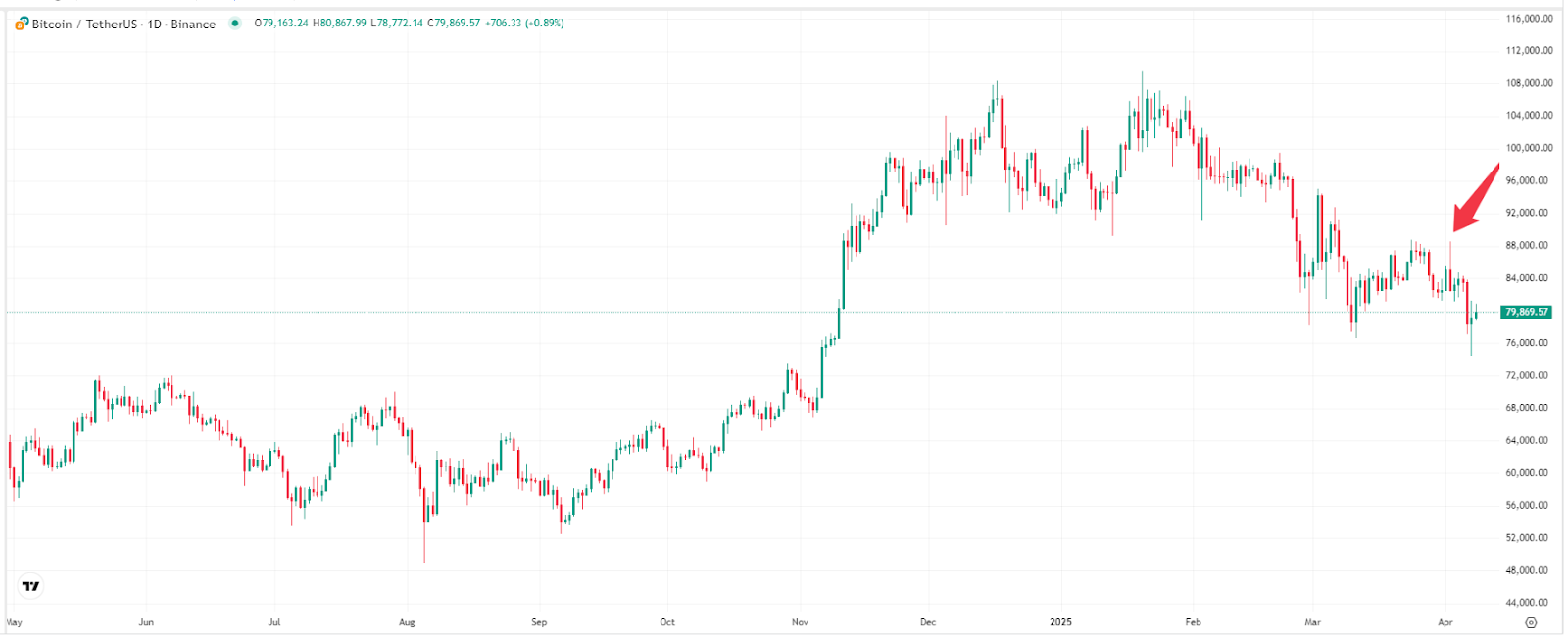How Trump's Tariffs Impact the Crypto Market and How Investors Should Respond

.jpg)
Introduction
TradingKey – U.S. President Trump’s tariff policies have a profound impact not only on traditional financial markets such as stocks and commodities but have also triggered complex ripple effects in the cryptocurrency market. From Bitcoin price fluctuations to shifts in investor sentiment, tariffs are becoming an increasingly important focus for crypto investors.
This article explores the impact of Trump’s tariff policies on the crypto market and offers strategies for navigating the changing landscape.
What Are Trump’s Tariffs?
Trump’s tariffs refer to a series of trade policies rooted in an "America First" approach, primarily aimed at reducing trade deficits and boosting domestic industries by imposing high tariffs on imported goods—especially those from China.
These policies were first proposed in 2016, implemented in 2017, and reached their peak between 2018 and 2019. In 2020, as the COVID-19 pandemic escalated, the Trump administration shifted its focus to crisis management and ease some trade tensions with China. From 2021 to 2024, President Joe Biden retained certain Trump-era tariffs. In 2025, with Trump’s return to the White House for a second term, a new and broader global tariff war was launched.
How Do Trump’s Tariffs Differ Between His Two Terms?
While Trump has consistently pursued tariff policies across both terms, the 2025 tariffs are notably more aggressive—covering a wider range of goods, targeting more countries, and imposing higher rates.
Policy Aspect | First Term (2017-2020)* | Second Term (2025-2028) |
Goods | mainly high-tech | all imports + punitive tariffs on key industries |
Countries | Mainly China | China, EU, Japan, Canada, Mexico, Vietnam, Thailand, India, South Korea, etc. |
Tariff Rate | Up to 25% on Chinese goods, 3-10% on others | 10% global baseline, 20-40% for many nations, up to 104% for Chinese goods |
Implementation Pace | Phased over 22 months (2018-2020) | Immediate enforcement |
Additional Measures | Export controls (e.g., Huawei ban) | "Zero-Sum Production" policy to reshore manufacturing |
Exemptions | 2,200 product exemptions | Minimal exemptions |
Direct Impact of Trump's Tariffs on the Crypto Market
On April 2, 2025, President Trump announced a universal tariff of at least 10% on all imports. He also introduced "reciprocal tariffs" on several countries with significant trade deficits with the U.S., including China, Vietnam, and Thailand, with rates reaching as high as 50%. These tariffs began to take effect between April 5 and April 9.
Following the announcement, Bitcoin(BTC) —the largest cryptocurrency by market capitalization—initially surged, but quickly reversed course. By April 7, BTC had dropped from $88,500 to a low of $74,500, marking a decline of over 15% in just five days. Other cryptocurrencies also suffered sharp losses, with Ethereum (ETH) and Ripple(XRP) each falling by nearly 28%.

Bitcoin Price Chart, Source: TradingView.
Additionally, U.S. cryptocurrency-related stocks also experienced declines following the announcement of new tariffs. Coinbase(COIN) fell by 8.96%, MicroStrategy (MSTR) dropped by 8.6%, and Bitfarms declined approximately 6.3%.
From 2016 to 2020, the crypto market—led by Bitcoin—was relatively unaffected by Trump’s tariff policies. The impact during that period was minimal due to two main factors: first, the tariffs were less severe; second, the crypto market was primarily driven by its internal catalysts, such as halving events, significant breakthroughs, and emerging trends.
Potential Impacts of Tariffs on the Crypto Market
Tariffs can have a range of effects on the crypto market. While they may trigger sharp declines in cryptocurrency prices and blockchain-related stocks, they can also result in positive outcomes under certain conditions. The long-term implications remain uncertain, but ongoing impacts are likely as the market becomes more integrated with global finance.
Mining Costs
As trade tensions escalate, the cost of importing technology products and services rises—especially for cryptocurrency mining equipment. Tariffs may prompt manufacturers to raise prices, limiting access for smaller miners or driving some operations out of the market. Such changes could weaken Bitcoin’s network security and reduce the overall hash rate.
Regulatory Policy Changes
Trump's trade policies may provoke retaliation from other countries, potentially leading to shifts in regulatory policies— not just for traditional financial markets, but also for the crypto space. Governments under economic pressure may implement tighter controls over cryptocurrencies.
Capital Flow
Tariffs could reduce global economic activity and liquidity. With less capital in circulation, speculative demand for cryptocurrencies may decline, impacting prices.
Federal Reserve Rate Cuts
Higher import costs caused by tariffs can lead to inflation, potentially prompting the Federal Reserve to cut interest rates sooner or more aggressively. Increased liquidity from rate cuts could, in turn, support higher cryptocurrency prices.
How Should Investors Respond?
Currently, we are in the early phase of Trump's presidency, with three more year of potential policy shifts ahead. He may further increase, reduce, or even eliminate tariffs, creating continued uncertainty. Regardless of the direction, the crypto market is likely to respond—especially as it becomes increasingly intertwined with traditional finance. This dynamic raises the stakes for investors.
Stay Flexible
In times of heightened market uncertainty, investors should maintain a flexible portfolios. During volatile periods, consider diversifying risk by allocating capital across multiple crypto assets, including stablecoins, rather than concentrating on a single asset.
Enhance Risk Management
Strong risk management is essential in volatile markets. Tools like stop-loss and take-profit orders can help limit potential losses and protect gains.
Monitor the Market
Investors should stay informed on U.S. economic developments, policy announcements, and market reports. Pay particular attention to the specifics of new tariff measures and their immediate effects on investor sentiment.
Consider Long-Term Investment
If investors have conviction in a particular cryptocurrency—such as Bitcoin (BTC)— a long-term holding strategy may yield better results amid short-term fluctuations. Historically, while crypto assets can be volatile , they have shown an upward trajectory over time.
Conclusion
Trump's tariff policy is unpredictable and has wide-ranging effects on the crypto market. For investors, understanding the underlying causal relationships is essential. To navigate this uncertain environment, it is important to remain flexible, conduct thorough market research, and consider long-term investment strategies. As the market continues to evolve, investors must be prepared to continuously adjust their approaches to keep pace with the rapidly changing landscape.







